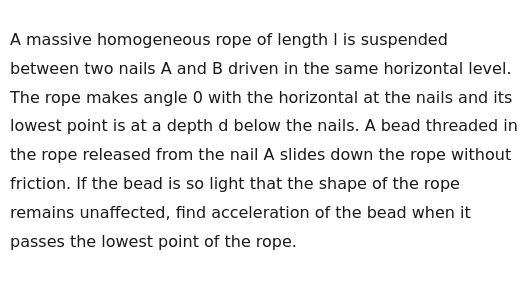Question
Question: A massive homogeneous rope of length l is suspended between two nails A and B driven in the same hor...
A massive homogeneous rope of length l is suspended between two nails A and B driven in the same horizontal level. The rope makes angle 0 with the horizontal at the nails and its lowest point is at a depth d below the nails. A bead threaded in the rope released from the nail A slides down the rope without friction. If the bead is so light that the shape of the rope remains unaffected, find acceleration of the bead when it passes the lowest point of the rope.

2g(secθ - 1)
Solution
The problem asks for the acceleration of a bead sliding without friction on a homogeneous rope, specifically when it passes the lowest point of the rope. The rope forms a catenary curve.
1. Determine the speed of the bead at the lowest point using energy conservation. Let the lowest point of the rope be the reference level for potential energy (PE=0). The bead is released from rest at nail A, which is at a depth d below the nails. This means the height of the nails relative to the lowest point is d. Initial energy at nail A: PEA=mgd, KEA=0. Final energy at the lowest point: PElowest=0, KElowest=21mv2. By conservation of mechanical energy: PEA+KEA=PElowest+KElowest mgd+0=0+21mv2 v2=2gd
2. Determine the acceleration at the lowest point. At the lowest point, the bead moves along a curve. Since the velocity is horizontal at this point, the acceleration is purely centripetal and directed upwards. The magnitude of the centripetal acceleration is a=Rv2, where R is the radius of curvature of the rope at its lowest point.
3. Find the radius of curvature of the catenary at its lowest point. The general equation for a catenary is y=ccosh(x/c), where c is a parameter. In this form, the lowest point of the curve is at (0,c). To find the radius of curvature, we use the formula: R=∣d2y/dx2∣[1+(dy/dx)2]3/2. For y=ccosh(x/c): First derivative: dxdy=c⋅c1sinh(x/c)=sinh(x/c) Second derivative: dx2d2y=c1cosh(x/c) At the lowest point, x=0: dxdy∣x=0=sinh(0)=0 dx2d2y∣x=0=c1cosh(0)=c1 Substituting these into the radius of curvature formula: R=∣1/c∣[1+02]3/2=1/c1=c. So, the radius of curvature at the lowest point of a catenary y=ccosh(x/c) is equal to the parameter c.
4. Relate the catenary parameter c to the given parameters d and θ.
Let the coordinates of the nails be (±x0,yA). The lowest point is at (0,c).
The problem states that the lowest point is at a depth d below the nails. This means yA−c=d, or yA=c+d.
So, at the nails, the coordinates are (±x0,c+d). Substituting into the catenary equation:
c+d=ccosh(x0/c)
1+cd=cosh(x0/c)
The angle θ the rope makes with the horizontal at the nails is given by the slope at x=x0: tan(θ)=dxdy∣x=x0=sinh(x0/c)
Now we use the identity cosh2u−sinh2u=1: (1+cd)2−tan2(θ)=1 (1+cd)2=1+tan2(θ)=sec2(θ) Taking the square root (since 1+d/c>0 and θ is an acute angle, sec(θ)>0): 1+cd=sec(θ) cd=sec(θ)−1 c=sec(θ)−1d=1−cos(θ)dcos(θ)
5. Calculate the acceleration. Substitute v2=2gd and R=c into the acceleration formula a=v2/R: a=c2gd Substitute the expression for c: a=1−cos(θ)dcos(θ)2gd a=cos(θ)2g(1−cos(θ)) a=2g(cos(θ)1−cos(θ)cos(θ)) a=2g(sec(θ)−1)
The final answer is 2g(secθ−1).
